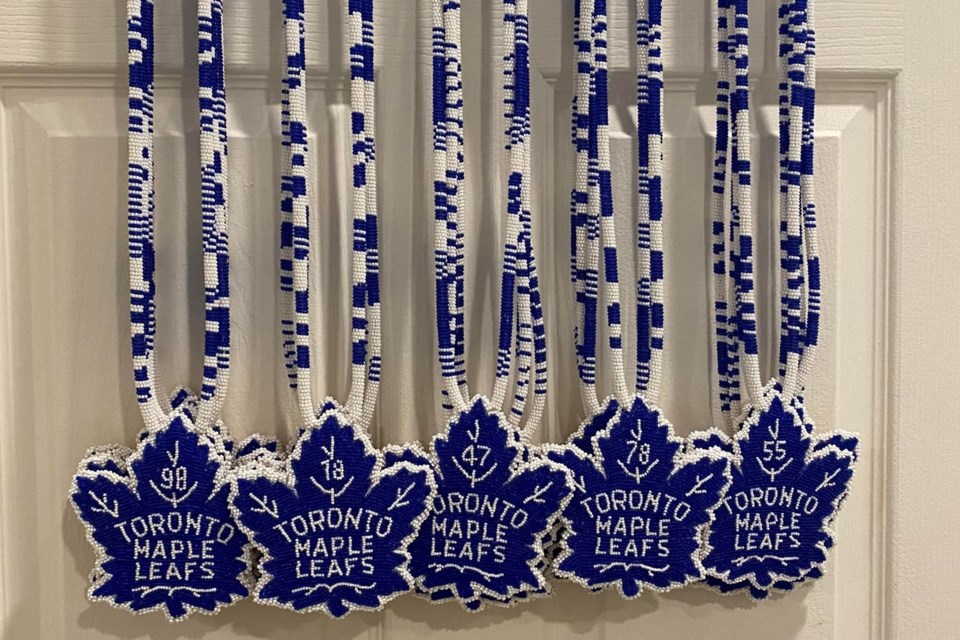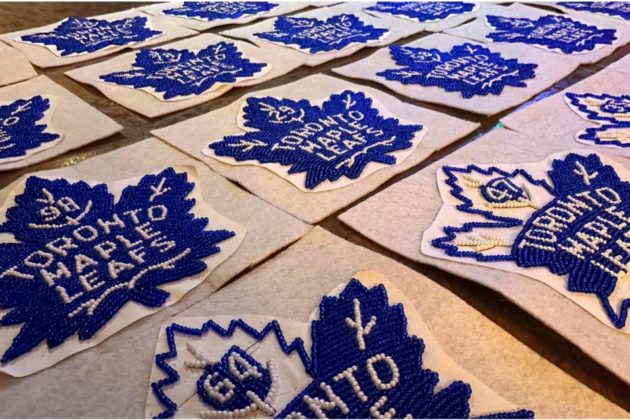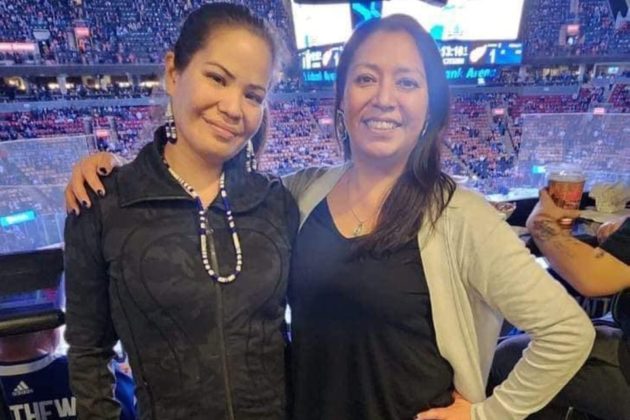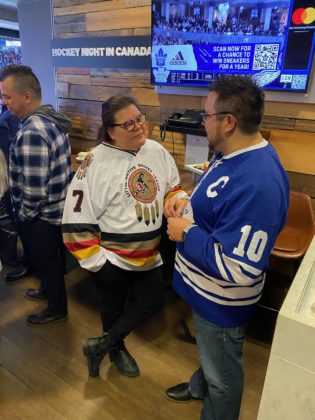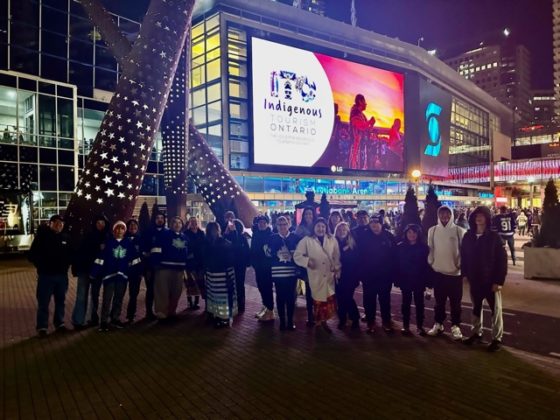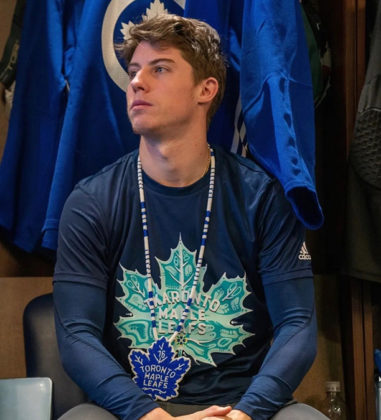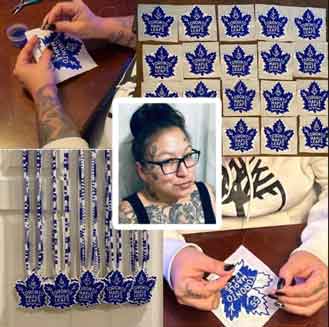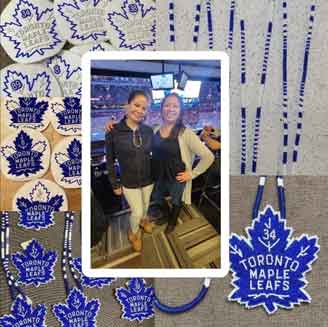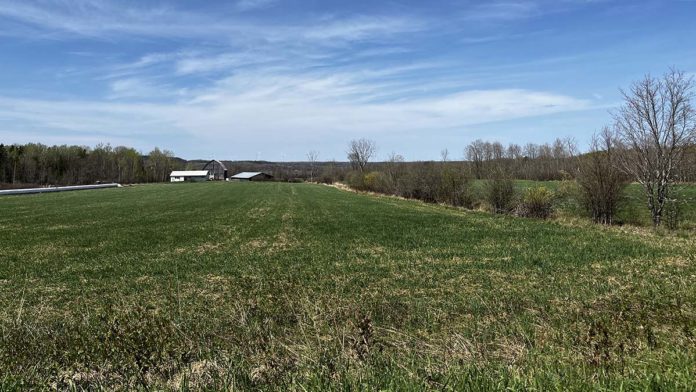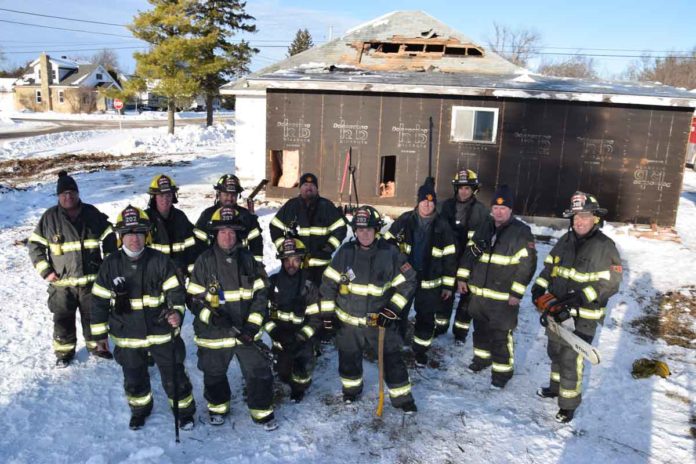TORONTO—While Indigenous Tourism Ontario (ITO) had over 100 people participating at the Toronto Maple Leafs Indigenous Celebration game on January 7 against the Detroit Red Wings, no one was more involved than Crystal Kimewon and five other Wiikwemkoong Unceded Territory kweok, as each of the Maple Leafs players sported the beadwork of the six women.
“We had to create 30 beadwork medallions in 30 days, one for each of the Maple Leaf players for their pre-game warmups,” said Ms. Kimewon, who along with Tara Kiwenzie, Lisa Lavallee, Theresa Wemigwans, Quinn Organ and Alaya Kimewon worked in quasi-assembly line fashion to complete the beautiful beadwork medallions. “Beadwork is my medicine,” she said. “It is my hobby and helps me stay balanced.”
Ms. Kimewon, who lives in Toronto and works as a front-line social worker at a Toronto shelter, told The Expositor that Marian Jacko, Little Native Hockey League president and Hockey Canada director who also hails from Wiikwemkoong, had initially come up with the idea for the medallions. Ms. Jacko approached Ms. Kimewon and Ms. Kiwenzie about making them.
“Marian had contacted Mark Hughes, manager of equity, diversion and inclusion, who said the team wanted the players to understand the magnitude and the significance of the gifts they received,” Ms. Kimewon said.
“I have experience in making large organization orders and I knew I could do 20 in the 30 days, and Tara helped by making seven. She contracted Lisa Lavallee to do three,” she said. “When I receive an order this large, especially right before Christmas, it requires some additional help.”
They recruited Theresa Wemigwans, her daughter Quinn and Ms. Kimewon’s daughter Alaya, and the six women completed the 30 medallions in 30 days.
Each of the beadwork medallions takes between 10 and 15 hours to complete. Adding to the difficulty, Ms. Kimewon explained, was “Maple Leaf players being traded or who were no longer with the team, so the numbers on the medallions were changing almost daily and I was in contract with the team just about every day. For the last two days, Theresa, Quinn and myself worked together.”
When she lived in Sudbury, Ms. Kimewon would facilitate beading socials at the Native Friendship Centre, where she taught techniques and trade secrets to learners that included Ms. Organ and Ms. Kimewon. “To look 10 years later and to see their skills having grown so much and to rely on them for such an important order was fantastic,” said Ms. Kimewon.
Ms. Kimewon met Mark Fraser near the arena on January 3 to deliver the beadwork. Mr. Fraser had asked that an insert be included with each of the medallions presented to the players, indicating the significance and meaning of the beadwork. “I reached out to Phyllis Williams Kimewon (in Wiikwemkoong) and asked her to help out,” she said.
Beads were considered M’nidoo spirit seeds. Originally, dried out animal bones were used to provide the blue tones. It was important to acknowledge the life gone into making the beads, Ms. Kimewon noted.
“It was beautiful doing this work,” she said. “We are all family. This is what we would have done hundreds of years ago in the winter.”
Each of the beadworkers were offered box seats for the Leafs game. “I’m not a hockey fan so I gave my tickets to the rest of our team,” Ms. Kimewon said. “It was an honour to do the beadwork for the team and the Maple Leafs, and to represent our community in this capacity.”
Several Manitoulin families attended ITO workshops on the Saturday leading up to the game. Families from Wiikwemkoong, Aundeck Omni Kaning, M’Chigeeng, and Curve Lake took part.
Kevin Eshkawkogan, president and CEO of ITO, told The Expositor, “Although there is a lot more work to do, the Leafs outdid themselves and set the bar for all professional sports teams in the way they were celebrating Indigenous traditions, food, dance, people and community. ITO is incredibly proud to have supported this amazing event.”
“Only five years ago, this type of event wasn’t at the forefront of anyone’s mind,” Ms. Eshkawkogan added. “This was a very positive event and ITO is already looking to do more with Leafs beyond Saturday night. We also look forward to further engaging with other sports teams at all levels across Ontario.”
“If we want to be exceptional, we must do exceptional things. This was exceptional,” he stated.
Glen Hare, regional grand chief for the Anishinabek Nation, was one of many Island First Nations people who attended the Indigenous Celebration game. “Everything was awesome,” he said. “It was good that the Leafs held Aboriginal Celebration Day. It was awesome, from the drummers and hoop dancers on the ice (including Wiikwemkoong’s Lisa Odjig).”
There were elements of Indigenous culture found everywhere in the Scotiabank arena: ITO videos during the game, the beaded medallions, and Maple Leafs players wearing a jersey with a logo designed by Ojibwe/Anishinaabe artist Tyler TaBobondung Rushnell. The event extended to the Toronto Marlies game on Sunday afternoon, with Marlies players wearing a commemorative patch during the game.
“George Armstrong was on the arena screen,” said Regional Chief Hare. “It was a night to enjoy. I think I’m starting to feel good when I travel around, and it has to do with reconciliation efforts.”

